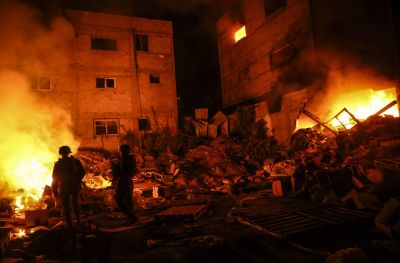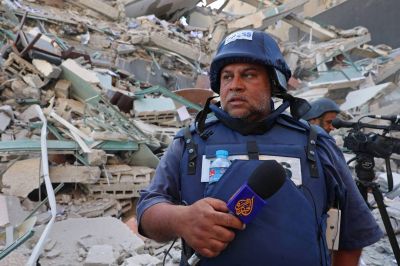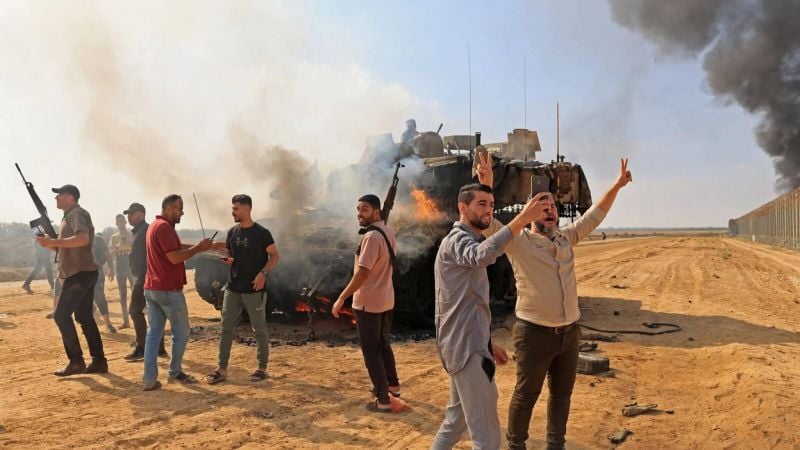
Palestinians take control of an Israeli tank after crossing the border fence with Israel from Khan Younis, in the south of the Gaza Strip, on Oct. 7, 2023. (Credit: Said Khatib/AFP)
BEIRUT — In 1989, current Hamas leader Yahya Sinwar was sentenced to life imprisonment for the murder of four Palestinians accused of collaborating with Israel and for planning of the abduction and murder of two Israeli soldiers.
He was expected to spend the rest of his days behind bars.
But 22 years later, he was released.
In 2011, Sinwar was freed as part of a prisoner swap deal between Hamas and Israel. More than 1,000 Palestinian prisoners were released in exchange for the release of Israeli soldier Gilad Shalit, who was captured in 2006 in a kibbutz near the Gaza Strip.
Twenty-two years later, Sinwar, who joined Hamas since its inception in 1987 and was close to its founder Ahamd Yassin, was no longer seen as a threat in the eyes of several Israeli intelligence officials.
He was no longer deemed young enough to plan a deadly attack. Among Hamas, he mostly earned an uncompromising reputation in dealing with Palestinians who collaborate with Israel.
Thirteen years later, Sinwar is Israel’s number one target, considered to be the mastermind of the biggest attack on the country since 1948.
To that end, Israel has said it won’t end its war in Gaza until he is dead or captured.
Sinwar is reportedly holed up in the underground tunnels within the coastal enclave, where he negotiated the details of a brief truce from Nov. 24 through Nov. 30. The agreement allowed the release of Palestinian prisoners in exchange for Israeli hostages captured on Oct. 7.
For the much-feared Hamas leader in Gaza, who ascended to his position in 2017, the issue of prisoners is of paramount importance. Sinwar has consistently urged the “resistance” to capture as many Israeli soldiers as possible to facilitate the release of Palestinian prisoners.
“I consider this a moral obligation,” Sinwar declared in a 2018 interview with a journalist from Israeli daily Yediot Aharonot. “I will do everything I can to free those who are still inside [Israel prisons].”
In prison, Sinwar’s charisma and authoritative presence positioned him as the leader among inmates. From his cell, he dedicated himself to studying Hebrew until he became fluent and delved into biographies of Israeli leaders with a singular goal: to understand the mindset of his enemy.
Triggering a seismic event — with more than 1,200 Israelis, mostly civilians, killed and nearly 240 people abducted, around a hundred of whom were exchanged during the ceasefire — the Oct. 7 offensive is of unprecedented magnitude.
Not all the shadows have been dispelled. Who planned Operation al-Aqsa Flood? Who was aware of it? What was Hamas’ objective?
Two months later, here’s everything we know.
Who are the architects of the operation?
According to Israeli officials cited by various media outlets in the past two months, Sinwar and Mohammad Deif, the shadowy leader of the Ezzedine al-Qassam Brigades since 2002, are the main architects of the assault.
Deif announced the start of the attack on Oct. 7 in a rarely heard audio message.
Both men, born in the Khan Younis refugee camp in the southern Gaza Strip, belong to the first generation of Hamas fighters and were arrested by Israel in the late 1980s.
Sinwar reportedly forged a closer connection with Deif in 2012 after becoming the representative of the military wing to the political leadership of Hamas.
While Sinwar operates publicly, Deif never appears in public — only three images of him, including one with a mask and another of his shadow, are known to publicly exist. Among the most sought-after leaders by Israel for over 25 years, Deif, the alleged planner of numerous suicide attacks against Israeli civilians in the mid-1990s and from 2000 to 2006, played a key role in developing the group’s tunnel network and bomb-making expertise.
 The shadowy leader of the Ezzedine al-Qassam Brigades since 2002, Mohammad Deif. (Credit: AFP)
The shadowy leader of the Ezzedine al-Qassam Brigades since 2002, Mohammad Deif. (Credit: AFP)
Remaining in the shadows is a matter of life or death for Deif. In the several Israeli assassination attempts against him, which claimed the lives of his wife and two children in 2014, he lost an eye in 2002 and suffered severe leg injuries in 2006. It is reported that he has been moving in a wheelchair since then.
The two men are believed to be currently in the labyrinth of tunnels beneath Gaza. The Israeli army, which expanded its ground operation to the city of Khan Younis, believes that both leaders are hiding there and states that the goal of its campaign is to locate, capture or kill them. Alongside them, a select circle of Hamas commanders in Gaza, including Marwan Issa, the deputy of Deif, is said to have planned the Oct. 7 assault, according to leaders of the Islamist movement and officials from Arab, Israel, and Western sources interviewed by The New York Times over several weeks.
When was the operation planned?
According to Israeli and Hamas sources cited by several media outlets in the past two months, the planning for the attack began in May 2021. This was after an Israeli police raid on the al-Aqsa Mosque compound in Jerusalem, the third holiest site in Islam, which resulted in injuries to hundreds of Palestinians and triggered an 11-day conflict between Israel and Hamas in Gaza.
“Hamas made such a decision in 2021, after its Sword of Jerusalem battle,” Adeeb Ziadeh, a Palestinian expert in international affairs at the University of Qatar, told L’Orient-Le Jour. “The goal was for the end of the blockade to be the price of this war.”
“But it was clear at that time that if the siege on Gaza was not lifted, they would carry out a more significant operation,” he added.
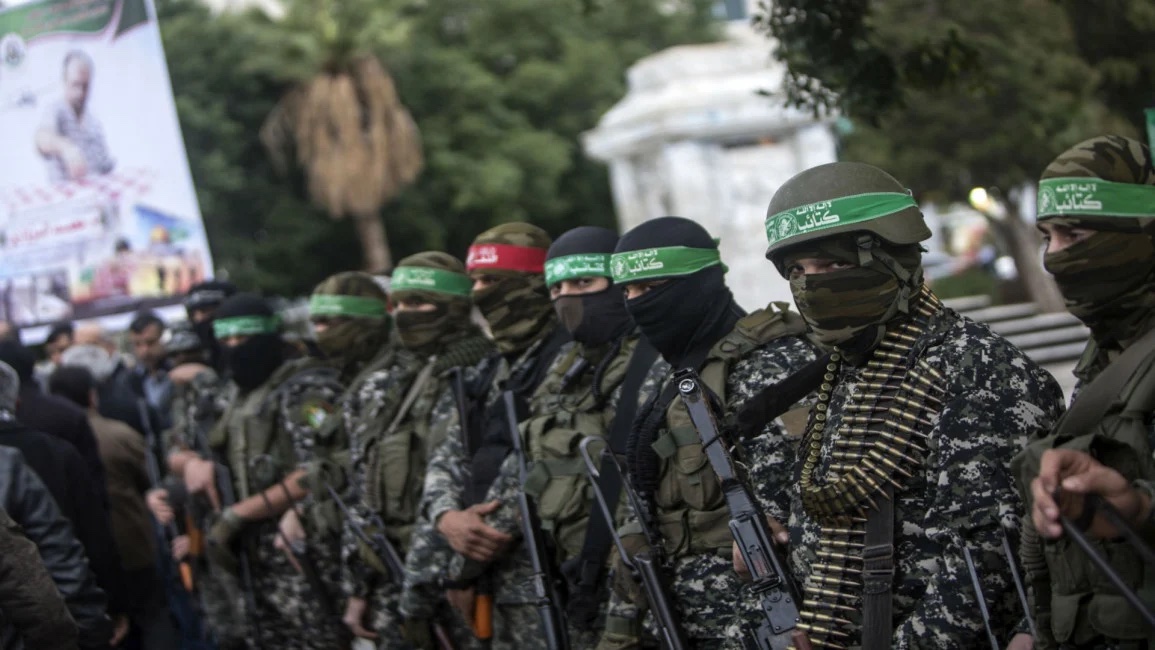 The Ezzedine al-Qassam Brigades. (Credit: AFP)
The Ezzedine al-Qassam Brigades. (Credit: AFP)
According to an interview with Hamas official Osama Hamdan in November by The New York Times, the Sword of Jerusalem operation marked a turning point. Hamas shifted from merely firing rockets in response to the situation in Gaza to actively fighting for issues concerning all Palestinians. The events also convinced Hamas that Israel was working to permanently bury the possibility of a Palestinian state. According to Hamdan, “The Israelis were only concerned with one thing: How do I get rid of the Palestinian cause? They were heading in that direction and not even thinking about the Palestinians. And if the Palestinians did not resist, all of that could have taken place.”
How did Hamas dupe Israel?
For Israel, after the Sword of Jerusalem operation, Hamas aimed to avoid a confrontation. This approach was driven by the desire to maintain its hegemony, ensure stability in Gaza, and secure concessions from Israel, which typically granted work permits to tens of thousands of Gazans. A spokesperson for the Israeli army, quoted by Reuters, stated: “ We believed that the fact that they were coming in to work and bringing money into Gaza would create a certain level of calm. We were wrong.”
An Israeli security source explained to the news agency: “ They caused us to think they wanted money. And all the time they were involved in exercises/drills until they ran riot.”
The signals sent by Hamas, appearing moderate and portraying itself as a governing authority rather than a warlike group, were allegedly intended to deceive Israel. According to an Israeli security official cited by The Washington Post, Hamas even provided information about Islamic Jihad to strengthen the impression that they were interested in collaboration.
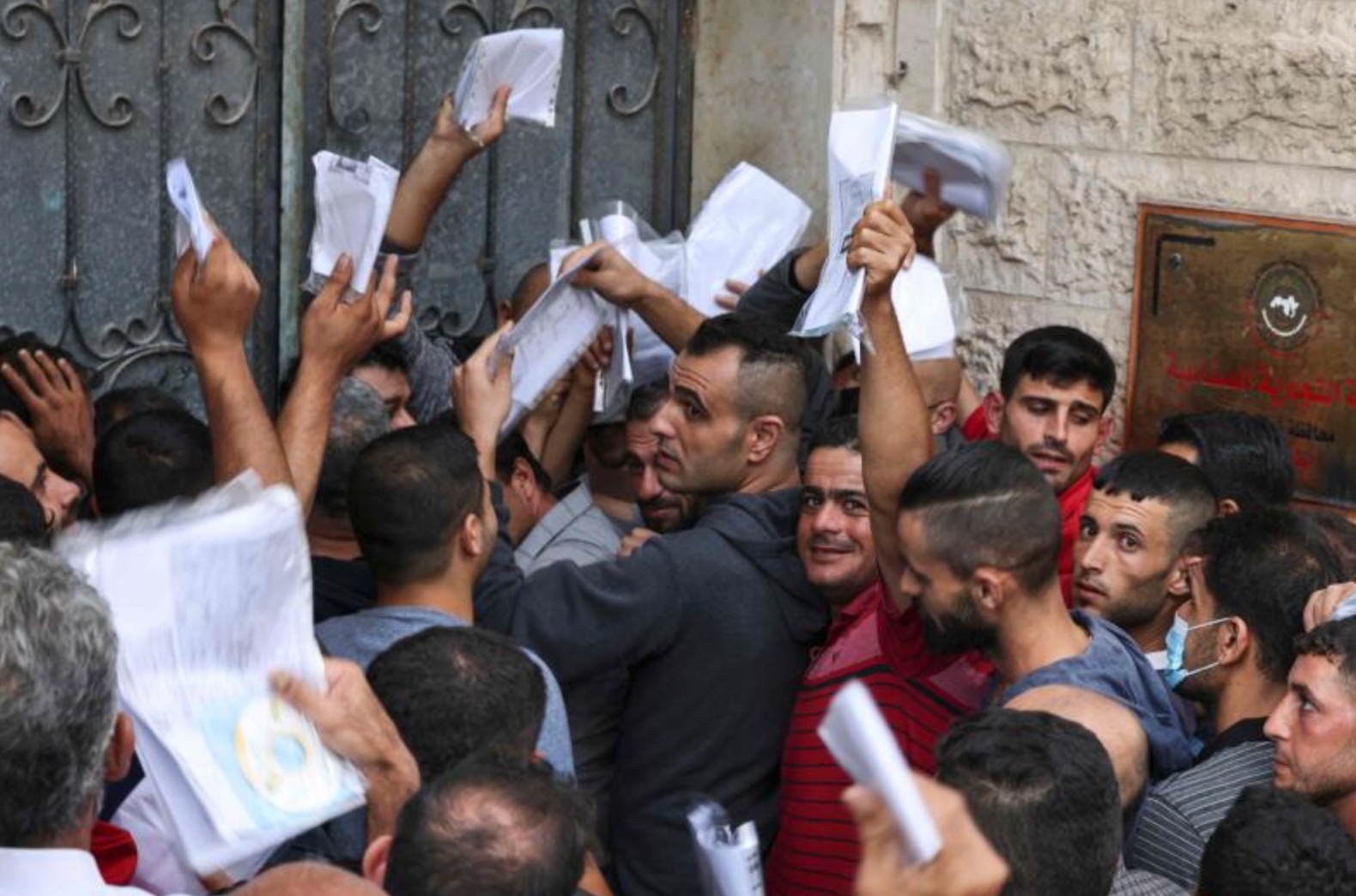 Palestinians trying to obtain work permits in Israel, at the Jabalia refugee camp, in the northern Gaza Strip, Oct. 6, 2021. (Credit: Mahmoud Hams/AFP)
Palestinians trying to obtain work permits in Israel, at the Jabalia refugee camp, in the northern Gaza Strip, Oct. 6, 2021. (Credit: Mahmoud Hams/AFP)
In May 2023, Hamas was notably absent from the last military escalation in Gaza before Oct. 7. Despite possessing a significantly larger arsenal than the Islamic Jihad, Hamas refrained from launching any rockets, instead supporting its smaller ally within a “joint operations room” comprising various armed factions.
“Hamas used an unprecedented intelligence tactic to mislead Israel over the last months, by giving a public impression that it was not willing to go into a fight or confrontation with Israel while preparing for this massive operation,” a source close to Hamas told Reuters.
The Israeli intelligence agency Unit 8200 had ceased monitoring the radio traffic of Hamas militants a year earlier, deeming it an inefficient use of resources, as reported by The New York Times.
Additionally, according to an Israeli security source cited by Reuters, some troops in the south of the country were not at full capacity as some had been redeployed to the West Bank to protect Israeli settlers.
“After the 2014 war, Hamas learned the lesson that it should preserve its military resources for a major conflict,” Palestinian political analyst Reham Owda, who recently fled Gaza, told L’Orient-Le Jour.
To avoid drawing attention to its real project, the Hamas decision-making cell planned its attack using a network of wired phones integrated into the labyrinth of tunnels beneath Gaza over a two-year period, according to information shared with the United States and confirmed in late October by two sources close to the matter speaking to CNN.
These phone lines allowed Hamas operatives to communicate secretly, avoiding detection by Israeli intelligence services. The sources added that the small cell remained in the shadows until it was time to activate and call hundreds of Hamas fighters to launch the assault. To avoid detection by Israeli or American intelligence services, the cell also refrained from using computers or mobile phones.
Who within Hamas knew about the operation?
In the past two months, several reports suggest that a very limited number of people outside of Gaza were informed about the operation.
“Clearly, the political leaders of Hamas, especially Ismail Haniyeh [head of the Hamas politburo in exile in Qatar], and other figures based in the Emirate, were caught off guard and surprised by the attack,” Mehran Kamrava, a professor of public administration at Georgetown University in Qatar, told L’Orient-Le Jour. He attributes this lack of knowledge to logistical challenges faced by military commanders in Gaza in staying in contact with political leaders in Doha without being detected.
“The operation was shrouded in secrecy and confidentiality. Given its scope, scale, and nature, it comes as no surprise that nobody else was privy to it,” he added.
Other observers underscored the discord between the political and military wings of the movement. Michael Horowitz, a Middle East specialist at LeBeck International, noted, “There has always been a divide between leaders ‘in exile’ in Qatar, Lebanon, Egypt or Turkey and the ones living in Gaza. Leaders in Gaza have typically looked at those in exile either with suspicion or contempt, or both.”
Among other examples, the appointment of Sinwar– known for his hardline stance – as the head of Hamas’ political bureau in Gaza in 2017, replacing Ismail Haniyeh, was seen as a move to sideline him.
The events of Oct. 7 raise questions about whether it was a coup within the military wing of Hamas.
Unlike Hezbollah, where fighters cannot act without the approval of leader Hassan Nasrallah, who embodies both the political and military wings, Hamas has a clear distinction between its two branches.
One Hezbollah official told L’Orient-Le Jour that the political wing of Hamas, including Haniyeh, was unaware of the attack.
In contrast, Hamdan, also interviewed by L’Orient-Le Jour, said that “Ismail Haniyeh was aware of the operation.”
What is the extent of Tehran’s involvement in the operation?
One of the central questions since Oct. 7 is the extent of Iran’s involvement in the attack.
Hamdan and a senior Hezbollah official both told L’Orient-Le Jour that neither Iran nor its Lebanese ally were aware of the operation.
On Oct. 10, Iran’s Supreme Leader, Ayatollah Khamenei, stated: “Those who say that the recent saga is the work of non-Palestinians are mistaken.” On Nov. 3, Nasrallah referred to it as “a 100-percent Palestinian operation.”
Despite statements from Western and Israeli intelligence services since Oct. 7, they claimed to have no evidence of direct Iranian involvement.
On Oct. 11, The New York Times reported that intelligence gathered by Washington indicated the Hamas operation even surprised key leaders of the Iranian regime, including individuals who would typically be aware of operations involving Iran’s Quds Force.
Given the sensitivity of such an operation, it appears logical that Tehran and its allies were not briefed on all the details to avoid jeopardizing its execution. However, numerous factors raise doubts about the idea that Iran was completely caught off guard by the Hamas attack.
While Hamas is not a purely ideological proxy of Tehran, it receives financial support, weapons and training from Iran. According to CNN, Israel estimates that Iran provides around $100 million annually to support the Islamist movement. This assistance has significantly bolstered Hamas militarily, including the transfer of expertise, in collaboration with Hezbollah.
In the same vein, after having fought on the opposing side during the Syrian war, Hamas has been integrated into the “axis of resistance” headed by Tehran, which includes Hezbollah in Lebanon and Syria, Iraqi Shiite militias and the Houthis in Yemen, who have all taken part in military operations against Israel and the US since Oct. 7.
The axis of resistance is guided by the “principle of unity of fronts” against Israel mentioned by Nasrallah at the beginning of 2023. Hamas armed wing also maintains particularly close links with Iran, and Sinwar is considered to be one of the figures behind the rapprochement between the two sides.
In 2017, Tehran praised Sinwar for assuming the leadership of the Hamas politburo in Gaza, seeing him as someone who wields great influence within the al-Qassam brigades.
Hamas was also successful in turning Lebanon into its rear base in recent years. Israeli intelligence services reportedly believe that the movement’s fighters have received training from Hezbollah.
On Oct. 9, several senior members of the “axis of resistance” told L’Orient-Le Jour that the operation had been prepared during months of meetings held in Beirut in a “joint military operations room” between senior members of Hezbollah, Hamas, Islamic Jihad and Iranian military officials, including Ismail Qaani, commander of the al-Quds Brigades of the Islamic Revolutionary Guard Corps (IRGC). The meetings intensified in the final few weeks leading up to the assault.
Moreover, The Wall Street Journal reported that the attack was closely coordinated with Tehran.
On Oct. 13, The New York Times also published an article casting doubt on Iran’s involvement.
It stated that, according to interviews conducted with three IRGC members, an Iranian official and a Syrian official close to Hezbollah, officials from Iran and Hezbollah “helped plan the attack starting over a year ago, trained militants and had advanced knowledge of it.”
The article also claims that Nasrallah told a meeting of “axis of resistance” leaders in March 2023 to “prepare for a war on a scale that would mark a turning point in the decades-long Arab-Israeli conflict.”
Also in the same article, The New York Times refers to an audio recording from last April, verified by the newspaper, in which an IRGC member said: “The message that is being communicated from Iran these days to the resistance is that we showcase a military maneuver to make the Zionist regime understand it is surrounded from every side.”
What did Israel know about Hamas’ plans?
This is a question that is particularly embarrassing for Israel as reports continue to come to light.
As much as a year ago, Israeli officials obtained the Hamas battle plan for the Oct. 7 attack, which was rejected by military and intelligence officials as too difficult to implement, The New York Times revealed in November. The 40-page document, entitled “Wall of Jericho,” describes point-by-point “the kind of devastating invasion” that actually took place, according to The New York Times.
Other evidence shows that many Israeli officials, deceived by Hamas’ facade of moderation, including Prime Minister Benjamin Netanyahu, repeatedly underestimated recent intelligence signals warning of a major attack on the border several months in advance. In March and again in July, military intelligence warned that Tehran-backed groups, including Hamas and Hezbollah, could launch an assault on Israel, which had been “weakened” by the internal political and social crisis, Haaretz reported. The Washington Post added that in August, new intelligence indicated that an attack was imminent.
Preparations by the Islamist movement, however, took place under the watchful eyes of Israel. According to CNN, the shadows and the sun’s position in the video indicate that the filmed training sessions lasted for hours or took place over several days, as detailed in the investigation. Additionally, Israeli officials appeared convinced that “the barrier” — the reinforced concrete wall surrounding the enclave completed in 2021 — would hermetically isolate Gaza, as reported by The New York Times.
Four senior Israeli army officers told the newspaper that there was a surveillance system at the border based almost exclusively on remote-controlled cameras, sensors and “shoot-on-sight” systems. Israel is said to have estimated that the combination of remote surveillance and machine-gun systems with the infamous wall would make it almost impossible to infiltrate the country and thus reduce the need to station large numbers of soldiers in the bases. On Oct. 7, the explosive drones used by Hamas damaged the cellular antennae and remote firing systems protecting the fence.
Added to this were the warnings from Cairo. According to an Egyptian intelligence source quoted by the Associated Press, Egypt warned Israel before the incursion that “something big” was being prepared from Gaza, a piece of information that the latter again ignored.
How was the operation carried out?
A source close to Hamas told Reuters that the Islamist movement deployed a force of around 1,000 fighters on the day of the attack, divided into specialized units.
On Oct. 7, the incursion by the Palestinian movement was threefold. First, it was carried out at dawn from the air, with a first salvo of rockets marking the start of the attack. Hamas claimed to have fired 5,000 rockets, while Israel claimed that half that number had been fired, reported the BBC.
The rocket barrage coincided with the neutralization of the wall’s surveillance systems, followed by incursions by fighters flying over the border in hang-gliders or motorized paragliders. Then part of the operation took place on the ground. Once the hang-gliding fighters landed, they secured the area so that an elite commando could lead the assault on the fortified wall built by Israel.
The fighters used explosives to get over the barriers and then cross them on motorbikes before bulldozers widened the gaps and other fighters entered in 4x4s, scenes described by witnesses. Some sources said that a total of 3,000 people crossed the fence with Israel from Gaza.
The operation was also carried out by sea, with some Hamas fighters attempting to bypass the fence completely by boat. The Israeli armed forces claim to have repelled two Hamas attempts to enter their territory by landing boats on the beach.
On the strength of its ability to outwit Israel, even Hamas was surprised by its success, according to Hamas officials and numerous Israeli security sources quoted by various media. The slow reaction of their forces on D-Day even enabled some units of fighters from the Islamist movement to make several trips to Israel from Gaza to bring back other hostages, according to Israeli officials quoted by The Guardian.
According to The New York Times, at 3 a.m. on Oct. 7, Israeli intelligence and national security officials, who had spent hours monitoring Hamas’s unusual activities in the Gaza Strip, initially thought it was just a night exercise. Ronen Bar, the head of the internal security service, thought Hamas might attempt a small-scale assault and voiced his concerns to Israel’s top generals, ordering a group of elite anti-terrorist forces to deploy to the southern border.
“Until the attack began, no one thought the situation was serious enough to wake up Prime Minister Benjamin Netanyahu,” added three Israeli defense officials, quoted by the American daily.
What atrocities were committed by Hamas?
Over the last two months, the crimes perpetrated by Hamas on Oct. 7 have fueled numerous rumors. An analysis published by Haaretz on Dec. 4 took stock of the situation.
The Israeli daily reported cases of sexual assault, rape, mutilation, the tying up of certain victims and the desecration of corpses. It also reported that houses were been burnt down, some with their inhabitants still inside.
Sources from the Israeli National Insurance Institute, kibbutz leaders and the police told Haaretz that a baby girl was also murdered on Oct. 7 in a kibbutz. The police have no evidence that other babies were killed, Haaretz added. According to the National Insurance Institute, five other children aged six or under were murdered, including a two-year-old and his six-year-old twin sisters in another kibbutz. Others were killed in a Hamas rocket attack or murdered with their families near Sderot.
Haaretz added that 14 children aged between 12 and 15 were killed when rockets were fired from Gaza.
The newspaper also discredited rumors that spread widely after Oct. 7, including one accusing Hamas of having murdered several dozen babies, some of them decapitated.
Netanyahu had also told Joe Biden that Hamas fighters “took dozens of children, tied them up, burnt them and executed them.” However, Haaretz reported that there is no proof that children from different families were murdered together, which makes this remark inaccurate. Many civilians, however, whose numbers are unknown, were tied up.
Meanwhile, an Israeli police investigation into the massacre at the Reim music festival near the Gaza border — where at least 260 festival-goers were killed and several taken hostage — has revealed that an Israeli attack helicopter may have killed some of the participants, Haaretz reported on Nov. 18. Arriving at the scene from a nearby base, the aircraft is said to have hit some of its citizens while targeting the attackers.
Did the operation go according to plan?
For several weeks, the question has been raised as to whether the initial aim of the architects of the operation was to kill as many Israeli civilians as possible. Several Hamas officials have denied the atrocities perpetrated by the group in Israel.
Osama Hamdan told L’Orient-Le Jour that the assault was directed against soldiers and not civilians. Some of the movement’s leaders also suggested that the situation on the ground had gotten out of hand. According to sources quoted by The Guardian on Nov. 7, members of Islamic Jihad — who were not informed of the attack but joined it when the fence with Israel was broken — or civilians who had crossed the enclave’s wall amid the general chaos may have taken part in the operation.
However, numerous notes found on dead or captured Hamas fighters in Israel seem to demonstrate an aim to kill civilians, including meticulously detailed maps of kibbutzes targeted on Oct. 7. While the Hamas fighters who took part in the operation were not aware of its scale or completeness, an initial group of units was ordered to overwhelm Israeli military bases around Gaza or attack civilians in their homes, sources told The Guardian.
Another was to capture as many hostages as possible and bring them to the gaps in the fence where specialized squads were waiting to take them into the vast complex of tunnels under Gaza. According to The Washington Post, in a kibbutz in the Hamas-invaded town of Beeri, one slain fighter had a notebook on which were scrawled verses from the Quran and orders that read simply: “Kill as many people and take as many hostages as possible.” Others were equipped with gas canisters, handcuffs and thermobaric grenades designed to instantly turn houses into infernos, the daily added.
Hamas also deployed cheap surveillance drones to map Israeli towns within a few kilometers of the fence with Gaza, having obtained additional information from Gazan workers allowed into Israel, often in the same farming communities as those in the Islamist movement’s crosshairs, The Washington Post revealed.
What were Hamas’ objectives?
In his audio message announcing the operation, Mohammad Deif said that it was “the day of the great plan to end the occupation,” adding that the assault was the result of Israel’s long-standing blockade of Gaza, its occupation of Palestinian land and its crimes against Muslims, including the desecration of the al-Aqsa mosque in Jerusalem. These words suggest that one of the aims of the Islamist movement was to fundamentally change the strategic dynamic with Israel and the Palestinian Authority, which runs the occupied West Bank, with a view to supplanting the latter.
Until now, there has been a violent balance between Hamas and Israel: every two years, a military assault would be launched against the Gaza Strip, and Hamas would use the opportunity to renegotiate the entry of goods and people in order to ease the restrictions imposed by the blockade on the Palestinians of Gaza,” explains Tareq Baconi, an analyst associated with the Palestinian think tank Al-Shabaka. “What we saw on Oct. 7 was Hamas breaking this balance and going on the offensive.”
It is an objective that stems from the context of recent years: the intensification of colonization in the West Bank, the increase in settler attacks and Israeli army raids in the occupied territories, the growing number of Palestinian detainees in Israeli prisons and the normalization of relations between Israel and several Arab countries.
But had Hamas anticipated an Israeli response on such a scale? Since Oct. 7, more than 20,000 Palestinians have been killed in Gaza during the military ground and air campaigns conducted by Israel.
“Hamas knew very well what would happen in Gaza the next day,” a senior Israeli military official with access to sensitive intelligence, including interrogations of Hamas fighters and intercepted communications, told The Washington Post. “He wanted to buy his place in history — a place in the history of jihad — at the expense of the lives of many people in Gaza.”
“Hamas may have felt that it could reproduce previous wars against Israel, during which the increase in Israeli military losses and the growing number of civilian deaths in Gaza led to internal pressure [in Israel] and calls from the international community, including the United States, for [Hamas] to agree to a ceasefire,” Alan Pino, former American intelligence officer for the Middle East for 15 years, told the Atlantic Council.
Hamas may have hoped that the Israeli response would be curbed by the presence of the hostages, the difficulty of the urban terrain in Gaza and the threats from Iran and its allies.
Some observers have suggested that the group made several miscalculations. One of these miscalculations was that Hamas expected the “axis of resistance” to fully join the “grand plan” announced by Mohammad Deif, writes Michael Horowitz in Majalla.
Nor did the Islamist movement expect the massive deployment of American military resources in the region, which certainly dissuaded Tehran from taking a direct part in the confrontation.
This article was originally published in French in L'Orient-Le Jour. Translation by Sahar Ghoussoub.
